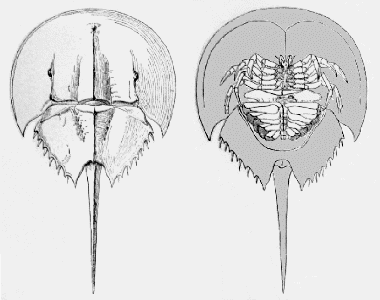
Consulting Entomologist

Tel/Fax: 01275 854224
E-Mail: [email protected]
Site Guide
Site Search
Home Page
Career Page
Insect Files
- Contents
- Bug Index
- The World of Bugs
- Classification of Bugs
- Insect Identification
- Insect Fossils
- Insect Body-parts
- Micro View of Bugs
- Insect Life Cycles
- Insect Defences
- Insects of Nailsea
- Pesticide Safety
- Bibliography
Shortcut to the main groups of insects and other arthropods...
Bug Rhymes & Poems
Links
Shop
Payments (credit/debit card)
King Crabs |
Class: Arachnida Order: Xiphosura |
| Ancient survivors from a time before arachnids invaded the land . . . . . . | |
|
|
With the exception of a few mites which have returned to a marine way of life, the king crabs, also known as horseshoe crabs, are the only surviving arachnids which now still live in the sea, as did their long extinct ancestors that eventually colonized the land and gave rise to all the more familiar terrestrial arachnids found today, such as spiders, scorpions, harvestmen and the majority of mites. The king crabs are represented by little more than a handful of species found mainly in the seas around Malaysia and off the east coast of North America. They are bottom-living in moderately deep water (2-6 fathoms), where they burrow in the mud or sand, feeding mainly on shellfish and marine worms. At certain times of year, during the breeding season, some species migrate into shallower water just offshore in order to spawn. Females of these species lay clusters of eggs in several different 'nests' excavated in the sand. The eggs are usually buried several centimetres below the surface of the sand, and each 'nest' may contain up to a thousand eggs. One or two species do not bury their eggs, but carry them about attached to their body appendages. |
|
All the modern-day king crabs are more or less horseshoe-shaped with a long, stout spine projecting from the rear-end. There is a joint across the middle of the body between the cephalothorax (or prosoma) in front and the abdomen (or opisthosoma) behind. The hard carapace of the cephalothorax and fused dorsal plates of the abdomen form a broad, protective shield which covers the entire body and, when viewed from above, more or less completely hides the legs and other appendages (as shown in the illustrations above). The carapace bears a single median eye near the front and a pair of lateral eyes further back. In addition to the usual arachnid appendages - chelicerae (jaws), palps (short sensory appendages) and four pairs of walking legs - the abdominal segments have five pairs of plate-like appendages which support the external gills used for respiration. The tail spine is completely rigid and only moves at its basal articulation to the abdomen. It appears to be used as a kind of lever, mainly to exert a pushing purchase when the animal is burrowing or when it falls on its back and needs to turn over. | |
|
RELATED PAGES (Other Arachnida) | ||||
|
FALSE SCORPIONS (Pseudoscorpiones) |
WHIP SCORPIONS (Pedipalpi) | |||
|
SCORPIONS (Scorpionidea) |
HARVESTMEN (Opiliones) |
MITES (Acari) |
WIND SCORPIONS (Solifuga) |
SPIDERS (Araneae) |
 (classification of arachnids) |
| <<< TOP | (use the back button on your web browser to return to the previous page) | TOP >>> |
